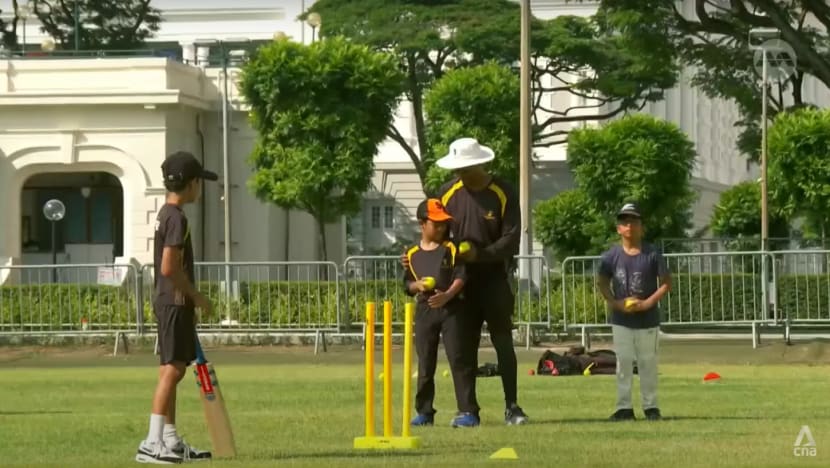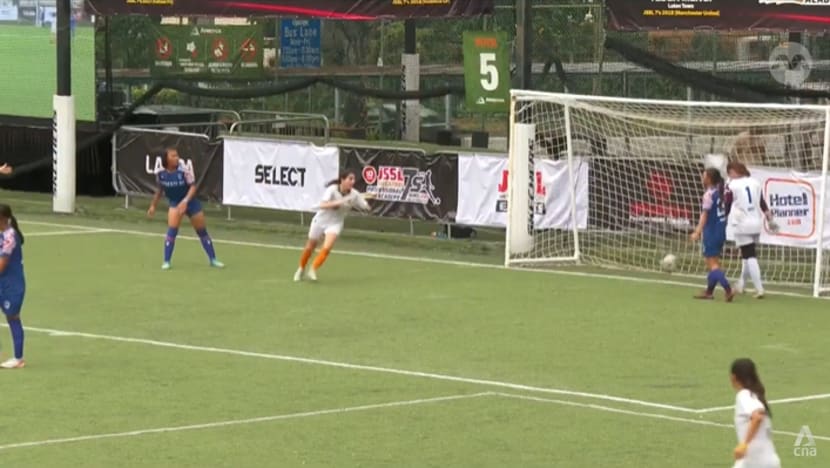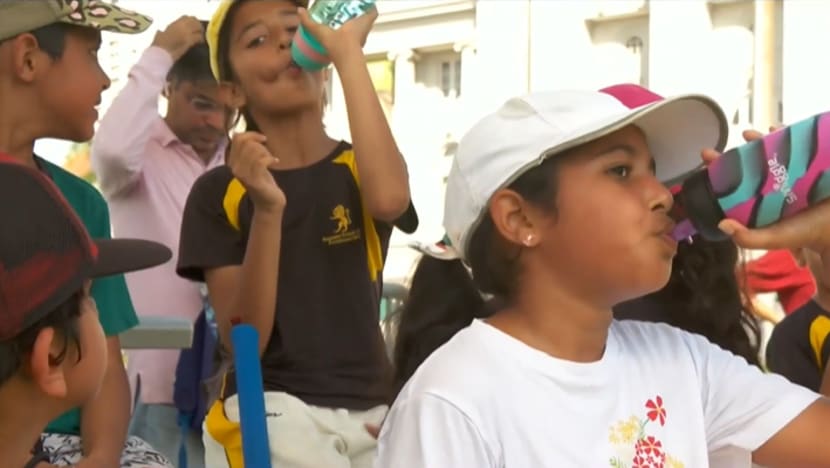Water breaks, ice baths, modified training: Youth sports organisers do more to beat the heat
Adults should watch out for early warning signs of heat-related injuries in young athletes, who are more likely to suffer from them, says an emergency medicine doctor.

Youths playing cricket at the Padang, accompanied by Mr Arun Vijayan, one of the head coaches of the Singapore Cricket Club’s Cricket Academy.

This audio is generated by an AI tool.
SINGAPORE: As temperatures soar and the ultraviolet (UV) index hits extreme levels in Singapore, organisers of youth sports from football to cricket are going the extra mile to ensure their players stay safe.
These measures include more water breaks, shelters and modified training sessions, the organisers told CNA.
An expert cautioned that with youths being more susceptible to heat-related injuries, parents and teachers should be on the lookout for early warning signs of heat exhaustion and heatstroke, such as dizziness and nausea.
On Wednesday (Mar 27), the UV index – which measures the level of solar UV radiation on the earth’s surface – entered the extreme band around noon. It climbed to a high of 12 at about 12.45pm; the maximum reading is 15.
According to the National Environment Agency, temperatures from Tuesday to Friday will hit a high of 35 degrees Celsius. The agency issued an advisory last week for the public to wear more sunscreen and keep umbrellas and hats handy.
The Meteorological Service Singapore has said that 2024 could be warmer than last year, which will make it among the warmest on record.
The highest temperature recorded so far this year was 36.3 degrees Celsius in Choa Chu Kang on Mar 24.
ICE BATHS, COLD WATER STATIONS
At the Singapore Cricket Club’s Cricket Academy, children aged eight to 10 get a break from the sun every 10 to 15 minutes. They can also use an ice bath in the nearby training shed and rest at sheltered areas with fans.
They are provided with T-shirts designed to dissipate heat, and their parents are advised on what to bring like sunscreen and water bottles, said head coach Arun Vijayan.
There is less emphasis on endurance or exertion during training sessions as well.
“We’ve got lots of experiences from the previous El Nino cycle … Our model has always been based towards that in terms of how we package our drills accordingly. So our drills are probably more towards ‘skills-based’ in this kind of weather,” Mr Arun added.
Over the past weekend, new measures were put in place to protect more than 6,000 players aged between six and 16 at Asia’s largest youth football tournament held in Singapore.
The JSSL Singapore Professional Academy 7s tournament, which ran from Mar 28 to 31, attracted 480 teams from 16 nations such as Spain, England, Malaysia and Indonesia.

When the weather was deemed to be too hot, they were given a one-minute water break in the middle of the 25-minute matches.
The teams were allowed unlimited substitutions, and numerous shelters and cold water stations were set up across the five venues.
While most of the teams are from Southeast Asia and are used to the heat, those from colder climates had to “try to get acclimatised in the short timeframe”, said tournament director Harvey Davis.
These included professional teams like Everton Football Club, situated in the northern region of England.
“We’ve given them cooling towels, ice everywhere,” Mr Davis added.
“I think the Asian teams, they’re used to training and playing in these kinds of conditions. They appreciate the ice, the water. I think in their normal countries when they play games, they don’t get treated the same way.”
Former England and Liverpool professional midfielder Danny Murphy, who was in Singapore for the tournament, said that playing in different weather conditions helps create resilience in players.
“If you want to play football, you have to be adaptable to play in different climates whether it’s really hot, humid, whether it’s freezing cold,” he pointed out.

WHAT IS CONSIDERED TOO HOT?
But when is it too hot to stop physical activities outdoors?
Dr Ian Mathews, senior consultant at the National University Hospital’s department of emergency medicine, said there is no fixed temperature to determine this, but an average temperature of 36 degrees Celsius coupled with Singapore’s humidity is already in the dangerous territory.
Humidity last week was around 75 per cent due to the recent rainy season, Dr Mathews noted.
Singapore also uses the Wet-Bulb Globe Temperature in assessing heat stress. Days of high heat stress occur when wet bulb temperatures equal or exceed 33 degrees Celsius, with Singapore experiencing 37 such days last year.
Dr Mathews said: “Roughly anything above outdoor temperatures of 32 degrees, in our climate, we should already start thinking about ensuring adequate hydration beforehand.
“When we’re getting to 36 degrees Celsius, we should start thinking to hold off such exercise and activities as well.”
He noted that youths are more vulnerable to heat injuries compared with adults for a variety of reasons, including a high basal metabolic rate.
Youths also absorb more environmental heat, which increases their core body temperature, and they sweat less and at higher temperatures.
“More importantly, (a lot of adults) make conscious efforts to hydrate before exercise, before sport. But kids may not have that same mentality … to actively hydrate before an event, and they only seek hydration when they are thirsty or dehydrated already,” Dr Mathews said.
He advised that youths wear loose clothing during sporting activities. If they start feeling drowsy or lethargic, they should be moved to a shaded area and their clothing should be removed or loosened.
Dr Mathews also pointed out some early signs and symptoms of heat injuries, including dizziness, lightheadedness, headaches, nausea, vomiting and profuse sweating.
‘You can actually stop sweating because of the body being too dehydrated as well, so those are more dangerous warning signs,” he added.

















